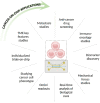Cancer-on-chip: a 3D model for the study of the tumor microenvironment
- PMID: 37592292
- PMCID: PMC10436436
- DOI: 10.1186/s13036-023-00372-6
Cancer-on-chip: a 3D model for the study of the tumor microenvironment
Abstract
The approval of anticancer therapeutic strategies is still slowed down by the lack of models able to faithfully reproduce in vivo cancer physiology. On one hand, the conventional in vitro models fail to recapitulate the organ and tissue structures, the fluid flows, and the mechanical stimuli characterizing the human body compartments. On the other hand, in vivo animal models cannot reproduce the typical human tumor microenvironment, essential to study cancer behavior and progression. This study reviews the cancer-on-chips as one of the most promising tools to model and investigate the tumor microenvironment and metastasis. We also described how cancer-on-chip devices have been developed and implemented to study the most common primary cancers and their metastatic sites. Pros and cons of this technology are then discussed highlighting the future challenges to close the gap between the pre-clinical and clinical studies and accelerate the approval of new anticancer therapies in humans.
Keywords: Cancer-on-chip; Metastasis; Microfluidics; Organ-on-chip; Pre-clinical models; Tumor microenvironment.
© 2023. BioMed Central Ltd., part of Springer Nature.
Conflict of interest statement
The authors declare no competing interests.
Figures









References
-
- Kocarnik JM, Compton K, Dean FE, Fu W, Gaw BL, Harvey JD, Henrikson HJ, Lu D, Pennini A, Xu R, et al. Cancer incidence, mortality, years of life lost, years lived with disability, and disability-adjusted life years for 29 cancer groups from 2010 to 2019: a systematic analysis for the global burden of disease study 2019. JAMA Oncol. 2022. 10.1001/jamaoncol.2021.6987. - PMC - PubMed
Publication types
LinkOut - more resources
Full Text Sources
Miscellaneous

